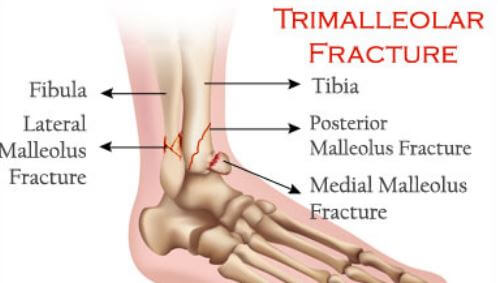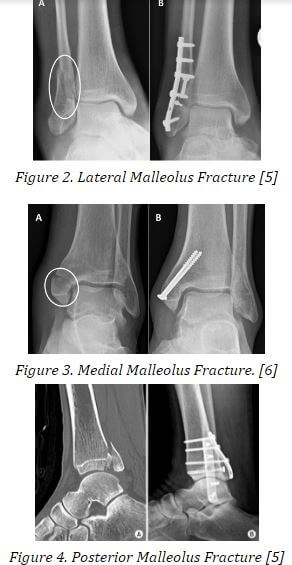Trimalleolar Fracture
Definition
Trimalleolar Fracture also known as the “break in bone” is the state of the bones where the three parts of the ankle are dislocated or has a fracture. The area that is affected is the medial malleolus, posterior malleolus and the lateral malleolus. This condition is considered as a unstable stage which can also lead to ligamentous injury if this parts are not properly addressed. [1][2]

Image 1 – Observe three malleolar breaks of bones
Causes Of Trimalleolar Fracture
Since the bone is involved and it is one of the strongest part of the body, the cause usually is caused by an impact or an accident affecting the normal position of the ligaments. [2]
- Big impact on the ankle during an accident
- Wrong positioning of the ankles while twisting and rotating
- Excessive rolling of the ankle
- Dislocation during a fall
- Tripping while walking or running
- Over usage of the foot or the ankle – usually causes stress fracture on the individual
Symptoms
The patient may experience the following signs and symptoms upon bone fracture:
- Severe pain
- Swelling of the ankle area
- Bruising
- Inflammation of the ligaments
- Dislocation or misplacement of the foot
- Pain upon carrying weights on the injured ankle
- Tender upon palpitation
Diagnosis
Some of the fracture in the bones may not be necessary for imaging tests but severe complications may need for further assessment and diagnosis. [7]
X-rays
Most fractures are requested to undergo x-rays to assure the different angles are being seen. Usually this diagnostic exam assures no overlapping of results and images of the bones.
Bone scan
A dye is being injected to the vein to give a cleared image of the bones. The significance of the dye or radioactive material is that they are attracted to the damage areas giving a result for the fracture area.
Computerized Tomography (CT)
This image tests gives a more accurate reading of the frature area because it captures the bone and the tissue involved.
Magnetic Resonance Imaging (MRI)
This test uses radio waves and a strong magnetic field to give a more precise imaged of the fracture. The areas that were not captured in the X-rays are being noted in the MRI.
Treatment
Medications to be taken
Narcotics/Analgesic – since there is severe pain noted on the patient, this type of medications relieves the pain.
- Morphine Sulfate – Duramorph, Astramorph, MS Contin
- Fentanyl Citrate – Duragesic, Sublimaze
Anxiolytic/Hypnotics – to decrease the anxiety felt by the patient d/t condition and pain
- Midazolam Hydrochloride – Versed
Antidotes – since the patient had taken sedations during the surgery there is a need to reverse its effect from the patient (which usually causes sedation and respiratory depression to the patient)
- Flumazenil – Romazicon
- Naloxene – Narcan
Antibiotics – since the patient is at risk for sepsis or infection there is a need to take antibiotics to prevent it.
- Cefazolin – Ancef, Kefzol, Zolicef
- Gentamicin – Gentacidin, Garamycin
- Vancomycin – Vancodin
Toxoids– the patient had screws, plates and other fixation devices that is usually made of metal, to reduce the risk for tetanus this medicine is being taken by the patient.
- Tetanus Toxoids
Immunoglobulins – to aid the immune system of the patients and to immunized them from Clostridium tetani products which is usually from the fixation devices.
- Tetanus Immune Globulin (TIG)
Surgery
Since it is a fracture in the bones and it concerns ligaments and joints surgeries are the most effective way to correct such condition: [2]
- Open Reduction and Internal Fixation (ORIF) – it brings the fracture bones back o the normal position by an open operation and inside the bones and ligaments. Upon once the bone is opened the area of the fracture will be placed with screws, pins or any fixation device to make sure that the bones re properly aligned and back to its normal positions.
- Bone Grafting – this procedure involves scaffolding a new bone to grow another bone. It usually aids in reducing the occurrence of arthritis on the ligaments.
There are also different approaches of this surgical procedure depending on which bone area is affected during the dislocation or fracture: [3]

- Lateral Malleolus Fracture – the bone are reduced into their normal alignment. The bones are held together with a screws and metal plates to attach the outer surface of the bone. [Figure 2]
- Medial Malleolus Fracture – since this a fracture that involves an impact or indent on the ankle joint, bone grafting is necessary. [Figure 3]
- Posterior Malleolus Fracture – the screws are placed from the front of the ankle to its back part (vice versa). Other procedures of this place the screw along the back of the shin bone. [Figure 4]
Risks
Operations and surgeries may have associated complications and risks since it involves an open procedure: [2]
- Diabetic individuals
- Increased in age
- Open existing fractures
- Smoking
- Compromised tissue repair
- Alcohol dependent
- Athletes who engages to high impact sports
- Cluttered materials at home or office
- Improper usage of sports materials
- Recurring conditions that does not encourage heavy lifting such as osteoporosis and neuropathy
Complications
- Hemorrhage or excessive bleeding since the bone is one of the organs that produces red blosd cells (RBCs)
- Sepsis or infection because the body is being open making it prone to different foreign objects anf microorganisms such as osteomyletis
- Post Traumatic Arthritis
- Delayed in the wound healing process resulting to a more unstable condition
- Stiffness or numbness
- Thrombosis or Embolism
- Damage on the nerves, tendons and blood vessels
- Difficulty in bone healing
- Tetanus
- Fracture blisters
- Muscular atrophy
- Cartilage degeneration
- Compartment syndrome
Recovery Time
Surgeries and operations are not easily healed and needs time to make sure that the patient can gain their body homoeostasis and to assure that the bones are properly back o it’s normal state. [2]
Usually the patient will have to wear a short-leg cast or a removable fracture boots to make sure that the legs fixation devices will be in place. This is usually left for about 5-6 weeks to make sure that the bones are fully recovered. Some patients usually takes 9-12 weeks before the full recovery. Once in a while, the patient has to undergone series of x-rays to check if the bones are properly aligned.
Reference
- http://radiopaedia.org/articles/trimalleolar-fracture
- http://www.sw.org/HealthLibrary?page=Trimalleolar%20Fracture,%20Ankle,%20Adult,%20Displaced%20(ORIF
- http://orthoinfo.aaos.org/topic.cfm?topic=a00391
- http://www.alphaanklearthroplasty.com/pg_anatomy.html
- http://www.southfloridasportsmedicine.com/medial-malleolar.html
- http://lfaclinic.co.uk/conditions/ankle-fracture-2/
- http://www.mayoclinic.org/diseases-conditions/broken-ankle/basics/risk-factors/con-20030768
